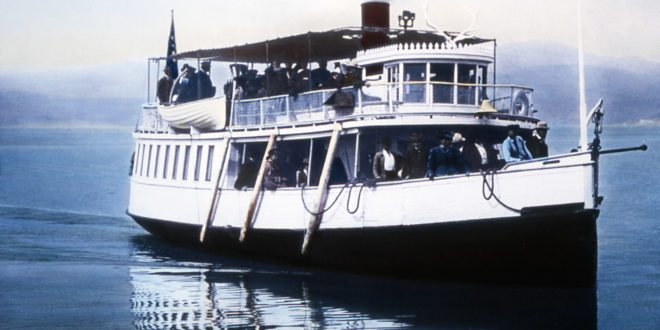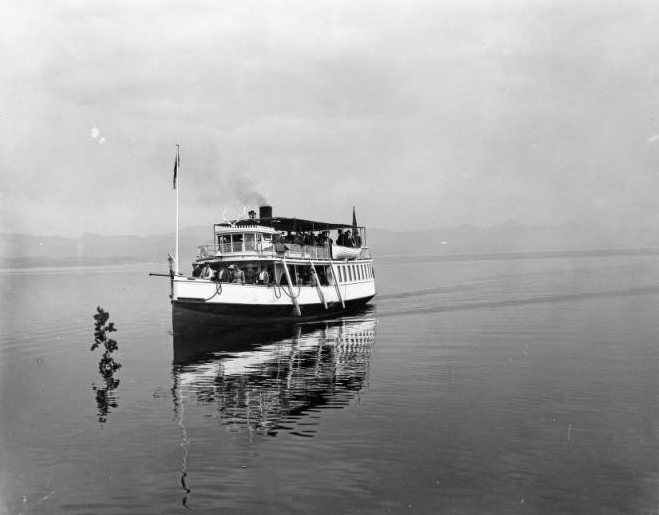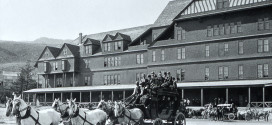The E.C. Waters may be the most famous boat in Yellowstone, but it had an important predecessor: the steamship Zillah.
Both owned and operated by the eponymous E.C. Waters (Yellowstone’s most hated businessman), both boats had markedly different careers. And fates.
As Mike Stark, writing in Wrecked In Yellowstone: Greed, Obsession, And The Untold Story of Yellowstone’s Most Infamous Shipwreck, relates, the E.C. Waters became a piece of living history, wrecked as it is on Stevenson Island in Yellowstone Lake, while the Zillah is a literal nonentity in the Park. No paying customer in Yellowstone ever rode the E.C. Waters, whereas the Zillah was one of the most successful transportation ventures in Yellowstone National Park.
The Useless
But why was that? You have to start at the beginning. From Wrecked In Yellowstone:
The [Zillah’s] origins were in Iowa. It had been built, mostly in Iowa, at a cost of $10,000 for Col. William McCrory, who owned the Minneapolis, Lyndale & Minnetonka Railway Company. At the time, his rail line had just expanded its operations to the small village of Excelsior on the shores of Lake Minnetonka, which was becoming a popular resort destination. McCrory hoped to profit by giving tourists a cleaner, smoother alternative to the horse-drawn carriages that left passengers rattled and coated in a layer of dust.
Unfortunately for McCrory, several structural flaws marred the boat. Its three-foot draft “was too deep for the shallow uneven contours of Lake Minnetonka” and it “listed badly” to the starboard side as it roared across the lake at its top speed of 16 mph. In addition, the whistle was ear-piercingly loud.
Locals dubbed it the Useless or McCrory’s Folly; a galled McCrory launched it anyway, snubbing his competitors and patrons with the boat’s obstinate, lopsided success. Along the way, McCrory made repairs and improvements to the vessel.
Although, as mentioned, the boat continued to succeed, its time on Lake Minnetonka was short. McCrory sold the boat in 1888 to a pair of brothers who rechristened it Clyde. Unfortunately, as lake levels dipped, Clyde couldn’t manage.
The Yellowstone Park Association purchased the boat in 1889 for $20,000; crews quickly chopped it into three pieces and shipped it thousands of miles to the shores of Yellowstone Lake, where it was reassembled. Stark opines the boat’s journey must have been marvelous. Alas, there’s “no historical record recounting the details” of the trip through Yellowstone. It must have been a sight, to say the least.
Waters rechristened Clyde the Zillah in honor of (and in deference to) the Northern Pacific Railroad Company; Zillah was the name of the daughter of NPRR President Thomas Oakes.
“Toylike At The Dock”
It’s hard to overstate just how popular the Zillah was with Yellowstone visitors. At its peak, thousands of people rode the vessel, stopping briefly at the Dot Island “Zoo,” where elk and bison were marooned and fenced in—to the delight of visitors, of course.
Indeed, such a state of affairs may have continued were it not for Waters, as Aubrey Haines relates in Volume 2 of The Yellowstone Story:
The [stagecoach] drivers knew there were nineteen miles of sandy road around Yellowstone Lake to the hotel near the outlet, so they were eager to “boat” as many of their dudes as possible at Thumb. As the coach rolled down that last grade toward the blue waters of Thumb Bay, where the steamer Zillah lay toylike at its dock, the driver began a softsell to get as many of his passengers aboard as possible. This boat ride was not a part of the regular tour, but an extra, costing an additional $2.50, so it was necessary to play up the advantages of the short cruise compared to the land route: absence of dust, freedom to walk about and stretch cramped legs, marvelous views of forested shores and islets backgrounded by magnificent, snow-capped mountains, and the stop at Dot Island to see live buffalo and elk close up. All those features were paraded before the tired dudes. And for every one put aboard the boat, the driver got fifty cents, or $5.50 for a coachload, which was a respectable bonus for a man whose wage was $50 per month.
But, as all good things come at last to an end, there came a day when Captain Waters, the boat concessioner, thought he could no longer afford to pay that fifty cents a head to the drivers. His decision was a mistake, for they boycotted him. It worked this way: when a coach came in sight of the boat dock, some tourist would be sure to ask about the steamer, whereupon the driver would mutter, “Oh, they got it back up again!” Of course he would be asked to explain and would enlarge upon the unseaworthiness of the Zillah. The tourists would want to know what they would miss if they didn’t take the boat. “Well, you’ll miss a swell drive—Arnica Creek, the knotty pines and the natural bridge,” they were told. So they stayed with the coach. One old driver said: “It was a shame. We’d get ’em on that hill (between Arnica and Bridge creeks) and they’d have to get out and walk to relieve the ponies.”
“Ghost of History”
In some ways, the Zillah was doomed merely for its association with Waters; Haines notes the vessel ran “without mishap,” carrying thousands of Yellowstone visitors over the years. Stark writes that, in a rare victory for Waters late in his concessioner career, he fended off accusations from Superintendent John Pitcher that the Zillah was not seaworthy—or in this case lakeworthy.
Indeed, the Zillah was not preserved for museum preservation or legacy usage. According to Stark, what happened to the boat is unknown:
The ultimate fate of the Zillah remains unclear, even after many years of park personnel and others searching for it. It was “an old rattletrap” by the early 1900s and only deteriorated from there. By the time [Yellowstone Park Company owner Harry] Child bought the boat company, the Zillah was out of commission. It became a ghost of history after that. It showed up in one photo from the 1920s, perched high and dry on the shore at Lake near one of its successors, the Jean D, but then largely disappeared from history.
Some said the Zillah was eventually towed out, purposefully punctured and jettisoned to the bottom of the lake. Others claim it was pulled apart and cannibalized for scrap. Either way was an ignominious end for a ship that turned out to be a stalwart and long-lived workhorse for Waters on Yellowstone Lake. Was anyone sad to see it vanish? Would anyone remember the tens of thousands of passengers it carried or the peculiar sight of it towing a barge full of bison and elk back and forth to Dot Island? The steel-hulled boat once called Useless had indeed faithfully fulfilled its duties for more than two decades in Yellowstone.
It’s fair to say the fate of the Zillah is worse than that of the E.C. Waters.
 Yellowstone Insider Your Complete Guide to America's First National Park
Yellowstone Insider Your Complete Guide to America's First National Park







You must be logged in to post a comment.